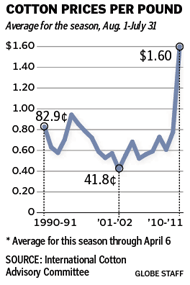Clothing prices hold steady no longer
Cotton cost adds to consumer woe
More polyester. Thinner shirts. Smaller buttons. The fallout from the cotton crisis looks like 1970s disco with way higher prices.
Following a 150 percent surge in cotton prices since August, apparel makers are now turning to cheaper fabrics, and scaling back details like tags and buttons to trim expenses. Retailers are also passing along the pain to shoppers with heftier prices — up 10 to 20 percent by year’s end, analysts predict.
“Unfortunately, the rising cost of raw materials will affect everybody,’’ said Luciano Manganella, owner of the local clothing chain 344, who expects to mark up merchandise roughly 10 percent in the coming months.
Many stores, which have kept prices flat or lower during the recession, have begun raising prices this spring to test how customers react, and more increases are expected for the back-to-school season from major brands like Gap, J.C. Penney, Levi’s, and Abercrombie & Fitch.
Some retail analysts say the projected 10 to 20 percent increases are the result of soaring costs for cotton, labor, oil, and other commodities.
At the Sells & Co. boutique in Winchester, cotton blend tank tops that cost $21 last fall are now $24,, and cotton blend T-shirts that cost $33 last season will go for $37 this spring.
Jeremy Rubman, retail strategist at consulting firm Kurt Salmon Associates, said shoppers have not faced such sticker shock for more than a decade. Since 1995, apparel prices have dropped 12 percent, prices for while food, medical services, and energy prices have all experienced double-digit increases, according to the Bureau of Labor Statistics.
The apparel industry was hurt after poor weather hurt cotton crops in China and Pakistan over the past several years and speculators then cornered the market. Demand far outstripped supply, and prices skyrocketed. Cotton hit a record high of $2.44 per pound on March 8: last year, cotton averaged about 77 cents a pound.
Katherine Hung, of Cambridge, said she won’t give up on cotton because it is the most durable fabric for her two young children, but she will adjust her shopping if the prices soar too high. “We’ll probably just have to buy less of it and wash more often,’’ Hung said.
Cotton Inc., an industry trade group, this week released estimates that consumers could pay up to $2.42 more for a pair of jeans if retailers passed on the entire price increase to shoppers. The group acknowledged that this projection accounts only for cotton fiber and not other commodities. But Cotton Inc. said a new survey revealed that consumers would be willing to pay more than 20 percent above the average price for a pair of jeans and T-shirt, if necessary.
“There may be some flexibility with pricing if [merchants are] trying to pass some costs onto the consumer, but the last thing a retailer or brand wants to do is sacrifice quality or ask the consumer to pay more for less,’’ said Melissa Bastos of Cotton Inc.
As apparel makers have sought alternatives to cotton, prices for other materials, like bamboo and silk, also spiked. Even demand for wood pulp — used to make polyester — is up.
“You can’t avoid the cost increases,’’ Rubman said. “Now there’s not even enough polyester to go around.’’
Jennifer Black, a retail analyst, said she believes price increases can succeed only on the chic and fashionable items.
“Basic items will not sell at higher prices,’’ Black said.
Karin Zin, of Newton, said she is not looking forward to more expensive clothes, especially after paying higher prices for food recently. She plans to get more secondhand garments from friends and buy items for her daughter on sale at the end of the season. But shopping for herself — not so much.
“The bottom line is I have to get stuff for my daughter because she grows,’’ Zin said.
Some merchants, worried that consumers will balk at paying more in a still tenuous economy, are looking for ways to mitigate expenses. Many retail executives have already lowered earnings guidance and issued warnings about the second half of the year. Abercrombie & Fitch Co., for example, just disclosed that its targeted 15 percent profit margin is unrealistic given the commodity and sourcing pressures, cost increases, among other factors.
The Gap Inc. and other big brands are planning to conduct “fabric engineering’’ — or reducing the amount of cotton. Man-made fibers such as spandex and viscose are often added to help clothes keep their shape and resist wrinkling, but many consumers perceive these materials as lower quality that result in stretchy pants and scratchy shirts.
Clothing chain Aeropostale Inc. is looking at less expensive graphics techniques and shrinking the amount of fabric it uses in tags — a move that will save the company 5 cents on every garment.
“A lot of retailers are passing all of the cost on to consumers. We just don’t think that’s realistic,’’ said Kenneth Ohashi, a spokesman for Aeropostale. “We will pass on some, but we are looking very carefully at ways to gain efficiencies without taking the quality out.’’
Jenn Abelson can be reached at abelson@globe.com. 

